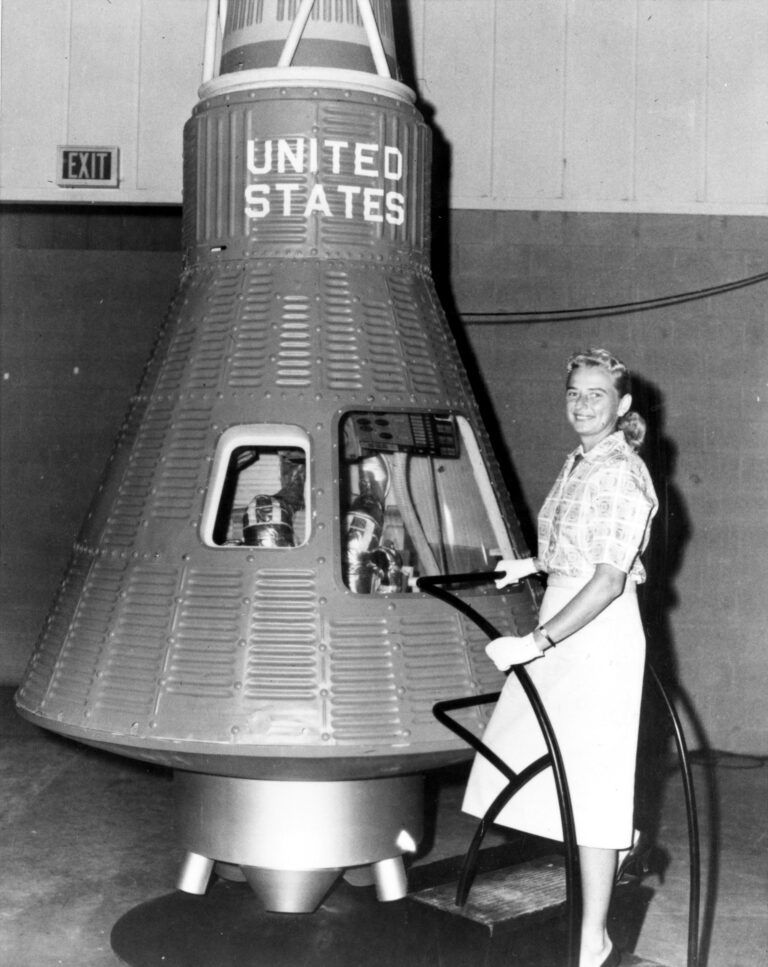
“To Boldly Go…”
Jerrie Cobb (1931-2019)
Jerrie looked to the skies, and dreamed of more. Born in Norman, Oklahoma; Geraldyne “Jerrie” Cobb took to the skies at a young age. Cobb first flew her father’s plane at age 12, and by 18, she had both her private and commercial pilot’s license. As flying jobs became scarce following the return of male pilots after World War II, Cobb kept flying by taking the less desirable jobs, such as crop dusting and oil pipeline patrol. By 1959, Cobb was a pilot and manager for the Aero Design and Engineering Company, and by 1960, she had more than 7,000 flight hours.
In that same year, Dr. William Lovelace, who helped create NASA’s testing protocol for astronaut candidates, and Brigadier General Donald Flickinger invited Cobb to undertake the same physical and medical tests as those candidates. Dr. Lovelace and General Flickinger thought that women would make good astronauts, because of their generally smaller heights and builds. Jerrie came to mind, because of her flight records.
By the end of 1960, Cobb completed the testing protocol, placing in the top 2 percent of all candidates. Dr. Lovelace released Cobb’s results the same year, and successfully recruited 12 more women to the project. They began testing in 1961, and Cobb began her NASA appointment as a consultant to the Space Program. Though the program was going well, the military abruptly canceled the training. Their reasoning? They claimed that the training was not requested by NASA.
Cobb immediately went to Washington DC to get the program reinstated. She and another participant, Jane Hart, started writing letters to President Kennedy and Vice President Johnson asking about the sudden cancelation. Their efforts culminated with a special hearing of the House Committee of Science and Aeronautics’ Subcommittee on the Selection of Astronauts in 1962.
Cobb and Hart both testified before the Subcommittee on July 17, 1962. The women’s goal was the immediate reinstatement of the program, and the successful candidates included in the next astronaut class (being picked that year). Unfortunately, Cobb was not successful. Women would not be included in an astronaut class until 1978.
After the subcommittee hearing, Cobb left her job at NASA, and continued flying planes. She never made it to space.

Sally Ride (1951-2012)
Sally Ride did not set out to make history. Ride was born in Los Angeles, and always had an interest in science. She earned her PhD in Physics at Stanford in 1978, where she was researching the effects of X-Rays on interstellar material. During her time at Stanford, Ride happened to see a NASA “help wanted” ad in the student newspaper looking for new astronaut candidates – with women and minorities explicitly encouraged to apply. Ride decided to submit an application, and of the over 8,000 initial applications, Ride and 200 others were invited down to the Johnson Space Center in Houston to do intensive physical testing. In early 1978, George Abbey, Director of the Johnson Space Center, woke Ride with a phone call that she was going to be one of 35 astronaut candidates in the 8th Astronaut Class.
Ride’s astronaut class was the first in 10 years, and was history making in its own right. It was the first to include women (6), African-Americans (3), and Asian-Americans (1). Ride, and the rest of her class, completed training in 1979, and quickly began making their mark on NASA. Ride’s class pioneered the Space Shuttle program, with Ride being Capsule Communicator on the ground for the 2nd and 3rd shuttle missions. Then, on June 18, 1983, almost twenty years to the day of the space flight of Valentina Tereshkova (the first woman in space), Ride took off from the Kennedy Space Center in space shuttle Challenger as a mission specialist – becoming the first American woman in space.
Ride flew one more time after her history-making flight. On October 5, 1984, Ride took off again from the Kennedy Space Center in Challenger. But this time, she was not the only woman in the crew. Kathryn Sullivan joined Ride on the mission, making history as the first space flight that included two women.
Ride never thought that she had done something extraordinary. All she thought was that she saw an opportunity, and she had seized it.

Mae Jemison (1956 – )
Young Mae Jemison dreamed of space. After seeing actress Nichelle Nichols’ portrayal of the character Lieutenant Ulhura in the original Star Trek, Jemison knew that is what she wanted to do. Jemison used her childhood dream to focus her studies in Chemical Engineering and African-American Studies, earning both a BA and a BS Stanford. After Stanford, Jemison earned her medical degree at Cornell, and worked as a doctor in the Peace Corps from 1983-1985.
Upon her return from the Peace Corps, and inspired by the flights of Sally Ride and Guion Bluford, the first African-American man in space, Jemison decided to apply in 1985 to be part of an astronaut class that was ultimately canceled due to the Challenger disaster. Jemison reapplied, and became one of the 15 that made up Astronaut Group 12 in 1987.
On September 12, 1992, Jemison took off in the space shuttle Endeavor on her only space flight. Jemison was part of the 50th space shuttle flight, and a joint mission with Japan to conduct life science experiments in space.
Upon her return, Jemison left NASA in 1993 to pursue other projects, which include the 100 Year Starship, a joint grant from NASA and the Defense Advanced Research Projects Agency (DARPA) for a private firm to create a business plan for viable interstellar travel within 100 years.


